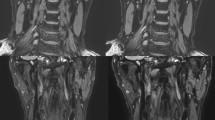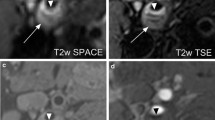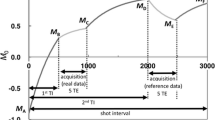Abstract
Objectives
To compare visualization of carotid plaques and vessel walls between 3D T1-fast spin echo imaging with conventional SPACE (T1-SPACE) and with a prototype compressed sensing T1-SPACE (CS-T1-SPACE)
Methods
This retrospective study was approved by the institutional review board. Participants comprised 43 patients (36 males, 7 females; mean age, 71 years) who underwent carotid MRI including T1-SPACE and CS-T1-SPACE. The quality of visualization for carotid plaques and vessel walls was evaluated using a 5-point scale, and signal intensity ratios (SRs) of the carotid plaques were measured and normalized to the adjacent sternomastoid muscle. Scores for the quality of visualization were compared between T1-SPACE and CS-T1-SPACE using the Wilcoxon signed-rank test. Statistical differences between SRs of plaques with T1-SPACE and CS-T1-SPACE were also evaluated using the Wilcoxon signed-rank test, and Spearman’s correlation coefficient was calculated to investigate correlations.
Results
Visualization scores were significantly higher for CS-T1-SPACE than for T1-SPACE when evaluating carotid plaques (p = 0.0212) and vessel walls (p < 0.001). The SR of plaques did not differ significantly between T1-SPACE and CS-T1-SPACE (p = 0.5971). Spearman’s correlation coefficient was significant (0.884; p < 0.0001).
Conclusions
CS-T1-SPACE allowed better visualization scores and sharpness compared with T1-SPACE in evaluating carotid plaques and vessel walls, with a 2.5-fold accelerated scan time with comparable image quality. CS-T1-SPACE appears promising as a method for investigating carotid vessel walls, offering better image quality with a shorter acquisition time.
Key Points
• CS-T1-SPACE allowed better visualization compared with T1-SPACE in evaluating carotid plaques and vessel walls, with a 2.5-fold accelerated scan time with comparable image quality.
• CS-T1-SPACE offers a promising method for investigating carotid vessel walls due to the better image quality with shorter acquisition time.
• Physiological movements such as swallowing, arterial pulsations, and breathing induce motion artifacts in vessel wall imaging, and a shorter acquisition time can reduce artifacts from physiological movements.






Similar content being viewed by others

Abbreviations
- CS:
-
Compressed sensing
- FSE:
-
Fast spin echo
- g-factor:
-
Geometry factor
- ICA:
-
Internal carotid artery
- mFISTA:
-
Modified fast iterative shrinkage-thresholding algorithm
- PI:
-
Parallel imaging
- SR:
-
Signal intensity ratio
- T1-SPACE:
-
T1-fast spin echo imaging with conventional SPACE
- VWI:
-
Vessel wall imaging
References
Feigin VL, Forouzanfar MH, Krishnamurthi R et al (2014) Global and regional burden of stroke during 1990-2010: findings from the Global Burden of Disease Study 2010. Lancet 383:245–254
Altaf N, MacSweeney ST, Gladman J, Auer DP (2007) Carotid intraplaque hemorrhage predicts recurrent symptoms in patients with high-grade carotid stenosis. Stroke 38:1633–1635
Wityk RJ, Lehman D, Klag M, Coresh J, Ahn H, Litt B (1996) Race and sex differences in the distribution of cerebral atherosclerosis. Stroke 27:1974–1980
Vermeer SE, Den Heijer T, Koudstaal PJ et al (2003) Incidence and risk factors of silent brain infarcts in the population-based Rotterdam Scan Study. Stroke 34:392–396
Sun J, Zhao XQ, Balu N et al (2017) Carotid plaque lipid content and fibrous cap status predict systemic CV outcomes: the MRI substudy in AIM-HIGH. JACC Cardiovasc Imaging 10:241–249
Zhao XQ, Hatsukami TS, Hippe DS et al (2014) Clinical factors associated with high-risk carotid plaque features as assessed by magnetic resonance imaging in patients with established vascular disease (from the AIM-HIGH Study). Am J Cardiol 114:1412–1419
Narumi S, Sasaki M, Natori T et al (2015) Carotid plaque characterization using 3D T1-weighted MR imaging with histopathologic validation: a comparison with 2D technique. AJNR Am J Neuroradiol 36:751–756
Zhang L, Zhang N, Wu J et al (2015) High resolution three dimensional intracranial arterial wall imaging at 3 T using T1 weighted SPACE. Magn Reson Imaging 33:1026–1034
Boussel L, Herigault G, de la Vega A, Nonent M, Douek PC, Serfaty JM (2006) Swallowing, arterial pulsation, and breathing induce motion artifacts in carotid artery MRI. J Magn Reson Imaging 23:413–415
Yamamoto T, Fujimoto K, Okada T et al (2016) Time-of-flight magnetic resonance angiography with sparse undersampling and iterative reconstruction: comparison with conventional parallel imaging for accelerated imaging. Invest Radiol 51:372–378
Fushimi Y, Fujimoto K, Okada T et al (2016) Compressed sensing 3-dimensional time-of-flight magnetic resonance angiography for cerebral aneurysms: optimization and evaluation. Invest Radiol 51:228–235
Stalder AF, Schmidt M, Quick HH et al (2015) Highly undersampled contrast-enhanced MRA with iterative reconstruction: integration in a clinical setting. Magn Reson Med 74:1652–1660
Rossi Espagnet MC, Bangiyev L, Haber M et al (2015) High-resolution DCE-MRI of the pituitary gland using radial k-space acquisition with compressed sensing reconstruction. AJNR Am J Neuroradiol 36:1444–1449
Fritz J, Raithel E, Thawait GK, Gilson W, Papp DF (2016) Six-fold acceleration of high-spatial resolution 3D SPACE MRI of the knee through incoherent k-space undersampling and iterative reconstruction—first experience. Invest Radiol 51:400–409
Altahawi FF, Blount KJ, Morley NP, Raithel E, Omar IM (2017) Comparing an accelerated 3D fast spin-echo sequence (CS-SPACE) for knee 3-T magnetic resonance imaging with traditional 3D fast spin-echo (SPACE) and routine 2D sequences. Skeletal Radiol 46:7–15
Lustig M, Donoho D, Pauly JM (2007) Sparse MRI: the application of compressed sensing for rapid MR imaging. Magn Reson Med 58:1182–1195
Yuan J, Usman A, Reid SA et al (2017) Three-dimensional black-blood T2 mapping with compressed sensing and data-driven parallel imaging in the carotid artery. Magn Reson Imaging 37:62–69
Yuan J, Usman A, Reid SA et al (2017) Three-dimensional black-blood multi-contrast carotid imaging using compressed sensing: a repeatability study. MAGMA. https://doi.org/10.1007/s10334-017-0640-1
Li B, Li H, Kong H, Dong L, Zhang J, Fang J (2017) Compressed sensing based simultaneous black- and gray-blood carotid vessel wall MR imaging. Magn Reson Imaging 38:214–223
Makhijani MK, Balu N, Yamada K, Yuan C, Nayak KS (2012) Accelerated 3D MERGE carotid imaging using compressed sensing with a hidden Markov tree model. J Magn Reson Imaging 36:1194–1202
Li G, Zaitsev M, Büchert M et al (2015) Improving the robustness of 3D turbo spin echo imaging to involuntary motion. MAGMA 28:329–345
Pruessmann KP, Weiger M, Börnert P, Boesiger P (2001) Advances in sensitivity encoding with arbitrary k-space trajectories. Magn Reson Med 46:638–651
Liang D, Liu B, Wang J, Ying L (2009) Accelerating SENSE using compressed sensing. Magn Reson Med 62:1574–1584
Boubertakh R, Prieto C, Batchelor PG et al (2009) Whole-heart imaging using undersampled radial phase encoding (RPE) and iterative sensitivity encoding (SENSE) reconstruction. Magn Reson Med 62:1331–1337
Kramer JH, Arnoldi E, François CJ et al (2013) Dynamic and static magnetic resonance angiography of the supra-aortic vessels at 3.0 T: intraindividual comparison of gadobutrol, gadobenate dimeglumine, and gadoterate meglumine at equimolar dose. Invest Radiol 48:121–128
Griswold MA, Jakob PM, Heidemann RM et al (2002) Generalized autocalibrating partially parallel acquisitions (GRAPPA). Magn Reson Med 47:1202–1210
Acknowledgements
We are grateful to Mr. Katsutoshi Murata and Mr. Yuta Urushibata, Siemens Healthcare Japan K. K., for protocol optimization.
Funding
This study has received funding by Grant-in-Aid for Scientific Research on Innovative Areas “Initiative for High-Dimensional Data-Driven Science through Deepening of Sparse Modeling,” Ministry of Education, Culture, Sports, Science and Technology (MEXT) grant numbers 25120002 and 25120008, and supported by The Kyoto University Foundation and JSPS KAKENHI Grant Number 18K07711.
Author information
Authors and Affiliations
Corresponding author
Ethics declarations
Guarantor
The scientific guarantor of this publication is Professor Kaori Togashi, MD, PhD.
Conflict of interest
The authors declare that they have no conflict of interest.
Statistics and biometry
No complex statistical methods were necessary for this paper.
Informed consent
Written informed consent was waived by the Institutional Review Board.
Ethical approval
Institutional Review Board approval was obtained.
Methodology
• Retrospective
• Cross-sectional study
• Performed at one institution
Electronic supplementary material
ESM 1
(DOCX 10237 kb)
Rights and permissions
About this article
Cite this article
Okuchi, S., Fushimi, Y., Okada, T. et al. Visualization of carotid vessel wall and atherosclerotic plaque: T1-SPACE vs. compressed sensing T1-SPACE. Eur Radiol 29, 4114–4122 (2019). https://doi.org/10.1007/s00330-018-5862-8
Received:
Revised:
Accepted:
Published:
Issue Date:
DOI: https://doi.org/10.1007/s00330-018-5862-8



